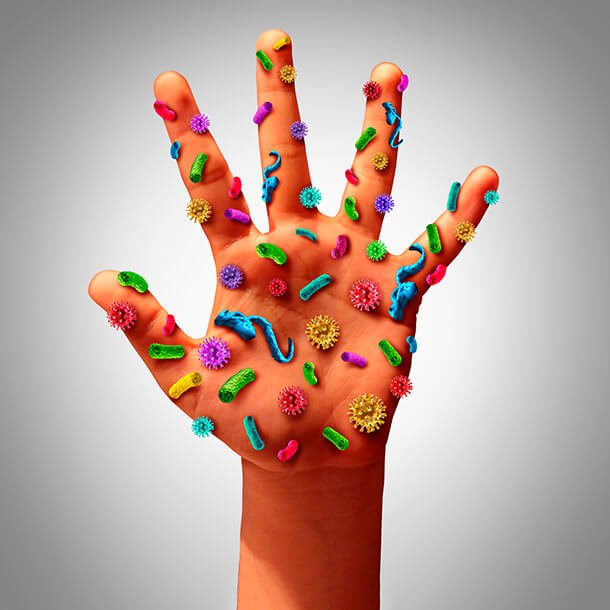Five Deadliest Communicable Diseases and What You Can Do to Stop Them

As a biohazard cleaning company, Aftermath cares about your health. This is why we’ve adopted February as Biohazard Awareness Month. This week, we’re examining the viruses and bacteria that lurk in body fluids, what we call biohazards, and how these bugs can contribute to serious disease and illnesses. Take a look at the the Five Biggest, Baddest Bugs around, and learn how you can avoid them.
Influenza
The flu is a contagious respiratory illness caused by influenza viruses that infect the nose, throat, and sometimes the lungs. It can cause mild to severe illness, and at times can lead to death.
Most experts believe that flu viruses spread mainly by tiny droplets made when people with flu cough, sneeze or talk. These droplets can land in the mouths or noses of people who are nearby. Less often, a person might also get flu by touching a surface or object that has flu virus on it and then touching their own mouth, nose, or possibly their eyes. On average, 200,000 Americans are hospitalized each year because of problems with the illness and 3,000 to 49,000 people die each year from flu-related causes.
MRSA
MRSA or Methicillin-resistant Staphylococcus aureus is a type of staph bacteria that is resistant to certain antibiotics called beta-lactams. These antibiotics include methicillin and other more common antibiotics such as oxacillin, penicillin, and amoxicillin. In the community, most MRSA infections are skin infections. More severe or potentially life-threatening MRSA infections occur most frequently among patients in healthcare settings.
Anyone can get MRSA on their body from contact with an infected wound or by sharing personal items, such as towels or razors that have touched infected skin. MRSA infection risk can be increased when a person is in activities or places that involve crowding, skin-to-skin contact, and shared equipment or supplies. People including athletes, daycare and school students, military personnel in barracks, and those who recently received inpatient medical care are at higher risk. There were 80,000 invasive MRSA infections and 11,285 related deaths per year (in 2011).
HIV
HIV stands for human immunodeficiency virus. It is the virus that can lead to acquired immunodeficiency syndrome or AIDS if not treated. Unlike some other viruses, the human body can’t get rid of HIV completely, even with treatment. So once you get HIV, you have it for life. Most commonly, people get or transmit HIV through sexual contact or sharing needles. Over 1 million people are living with HIV and 1 in 7 don’t even know it.
C. Diff
Clostridium difficile (also called C. difficile) are bacteria that can cause swelling and irritation of the large intestine, or colon. This inflammation, known as colitis, can cause diarrhea, fever, and abdominal cramps. Hospitals, nursing homes, and other healthcare facilities are the most common area of spread because workers are more likely to come into contact with the bacteria, and then with patients or residents. According to the CDC, there are 250,000 C. diff cases per year, 14,000 of which result in death.
HEPATITIS
Hepatitis refers to an inflammation of the liver cells and damage to the liver. There are different types and causes, but the symptoms can be similar. At least five viruses can cause hepatitis. Hepatitis B and C are the most harmful types of the Hepatitis virus.
Hepatitis B is caused by the hepatitis B virus (HBV) and is spread through contact with infected blood, semen, and some other body fluids. In the United States, an estimated 850,000-2.2 million persons have chronic Hepatitis B. Globally, chronic Hepatitis B affects approximately 240 million people and contributes to an estimated 786,000 deaths worldwide each year.
Hepatitis C kills more Americans than any other infectious disease. An estimated 2.7-3.9 million people in the United States have chronic Hepatitis C. Approximately 75%–85% of people who become infected with Hepatitis C virus develop chronic infection. Hepatitis C mostly results from percutaneous infection, occurring when the hepatitis C virus (HCV) virus gets under the skin. It is usually spread through injected narcotics, needle-stick injuries, and a lack of infection control in healthcare settings. About 3.5 million Americans are currently living with Hepatitis C and roughly half are unaware of their infection.
how you can stop these bad bugs in their tracks
PPE is one of the most effective means to limit your exposure risk and protects you against exposure to all of these diseases. If you come into contact with bio of any kind, remember to wear your PPE!
One of the most difficult aspects of these 5 diseases is the secretive nature of the organisms that cause them. After a biohazardous incident, we may have no way of knowing what sorts of bacteria or viruses are present. Many times individuals themselves are unaware of their infection. This is why Aftermath technicians employ proper and professional safety techniques to not only protect themselves during cleanup, but to ensure that our customers are not exposed to any potentially harmful organisms.
Aftermat is dedicated to helping families recover from all types of biohazard situations, including outbreaks of contagious illness. If you have experienced a biohazard situation in your home or place of business, consider giving the professionals a call. We’ll help you give your home or office a fresh start to a healthier year.
 877-872-4339
877-872-4339  Contact Us
Contact Us 







